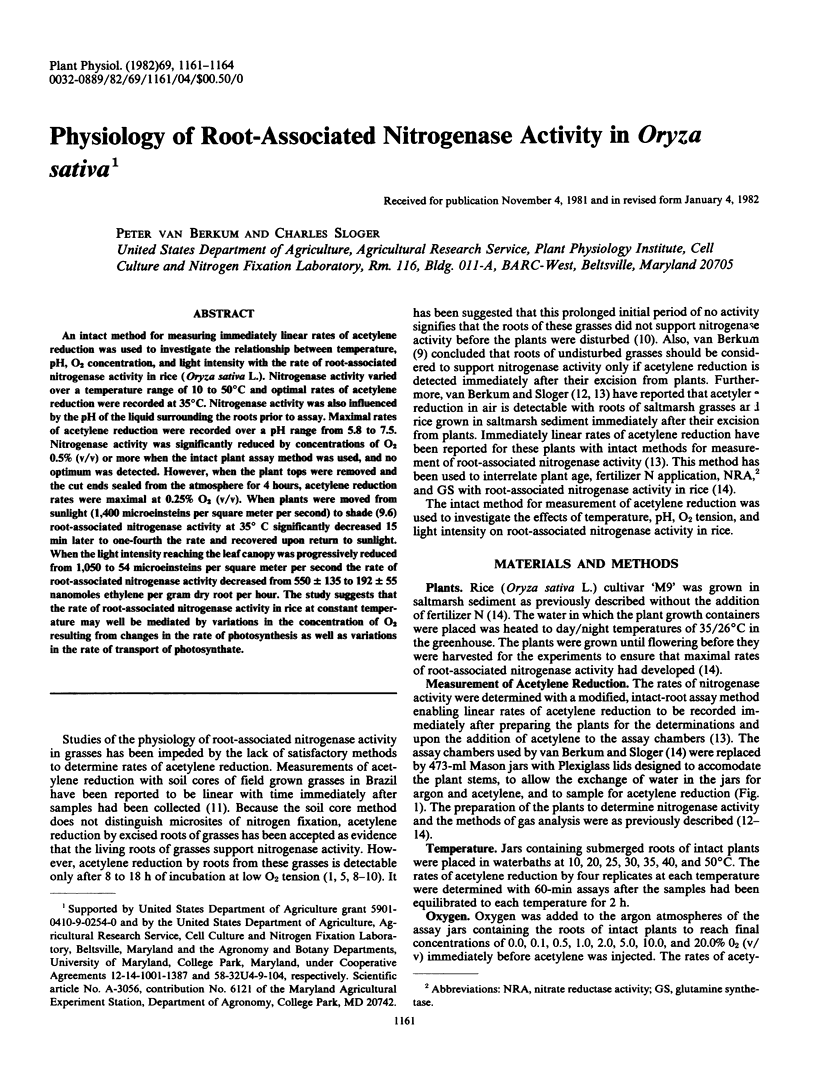Abstract
An intact method for measuring immediately linear rates of acetylene reduction was used to investigate the relationship between temperature, pH, O2 concentration, and light intensity with the rate of root-associated nitrogenase activity in rice (Oryza sativa L.). Nitrogenase activity varied over a temperature range of 10 to 50°C and optimal rates of acetylene reduction were recorded at 35°C. Nitrogenase activity was also influenced by the pH of the liquid surrounding the roots prior to assay. Maximal rates of acetylene reduction were recorded over a pH range from 5.8 to 7.5. Nitrogenase activity was significantly reduced by concentrations of O2 0.5% (v/v) or more when the intact plant assay method was used, and no optimum was detected. However, when the plant tops were removed and the cut ends sealed from the atmosphere for 4 hours, acetylene reduction rates were maximal at 0.25% O2 (v/v). When plants were moved from sunlight (1,400 microeinsteins per square meter per second) to shade (9.6) root-associated nitrogenase activity at 35° C significantly decreased 15 min later to one-fourth the rate and recovered upon return to sunlight. When the light intensity reaching the leaf canopy was progressively reduced from 1,050 to 54 microeinsteins per square meter per second the rate of root-associated nitrogenase activity decreased from 550 ± 135 to 192 ± 55 nanomoles ethylene per gram dry root per hour. The study suggests that the rate of root-associated nitrogenase activity in rice at constant temperature may well be mediated by variations in the concentration of O2 resulting from changes in the rate of photosynthesis as well as variations in the rate of transport of photosynthate.
Full text
PDF



Selected References
These references are in PubMed. This may not be the complete list of references from this article.
- Lee K. K., Watanabe I. Problems of the acetylene reduction technique applied to water-saturated paddy soils. Appl Environ Microbiol. 1977 Dec;34(6):654–660. doi: 10.1128/aem.34.6.654-660.1977. [DOI] [PMC free article] [PubMed] [Google Scholar]
- Watanabe I., Cabrera D. R. Nitrogen fixation associated with the rice plant grown in water culture. Appl Environ Microbiol. 1979 Mar;37(3):373–378. doi: 10.1128/aem.37.3.373-378.1979. [DOI] [PMC free article] [PubMed] [Google Scholar]
- van Berkum P., Bohlool B. B. Evaluation of nitrogen fixation by bacteria in association with roots of tropical grasses. Microbiol Rev. 1980 Sep;44(3):491–517. doi: 10.1128/mr.44.3.491-517.1980. [DOI] [PMC free article] [PubMed] [Google Scholar]
- van Berkum P., Sloger C. Comparing time course profiles of immediate acetylene reduction by grasses and legumes. Appl Environ Microbiol. 1981 Jan;41(1):184–189. doi: 10.1128/aem.41.1.184-189.1981. [DOI] [PMC free article] [PubMed] [Google Scholar]
- van Berkum P., Sloger C. Immediate acetylene reduction by excised grass roots not previously preincubated at low oxygen tensions. Plant Physiol. 1979 Nov;64(5):739–743. doi: 10.1104/pp.64.5.739. [DOI] [PMC free article] [PubMed] [Google Scholar]
- van Berkum P., Sloger C. Ontogenetic Variation of Nitrogenase, Nitrate Reductase, and Glutamine Synthetase Activities in Oryza sativa. Plant Physiol. 1981 Sep;68(3):722–726. doi: 10.1104/pp.68.3.722. [DOI] [PMC free article] [PubMed] [Google Scholar]


